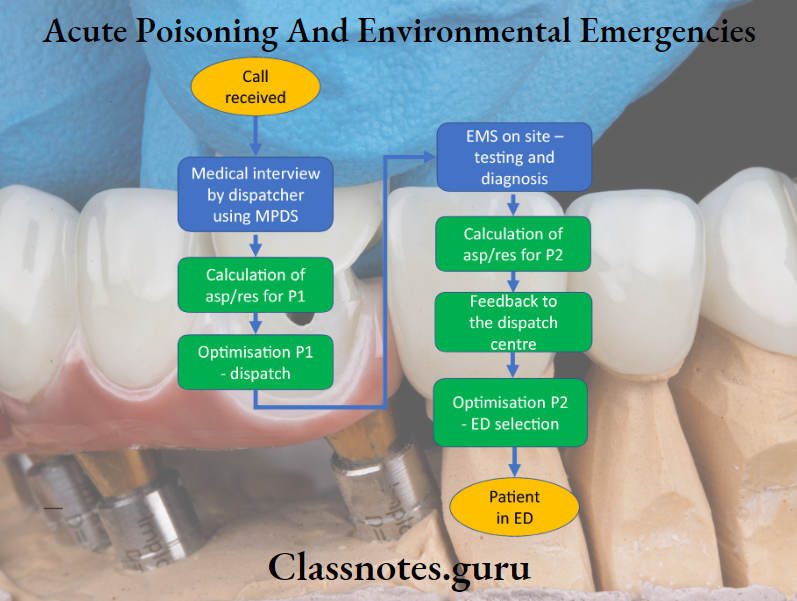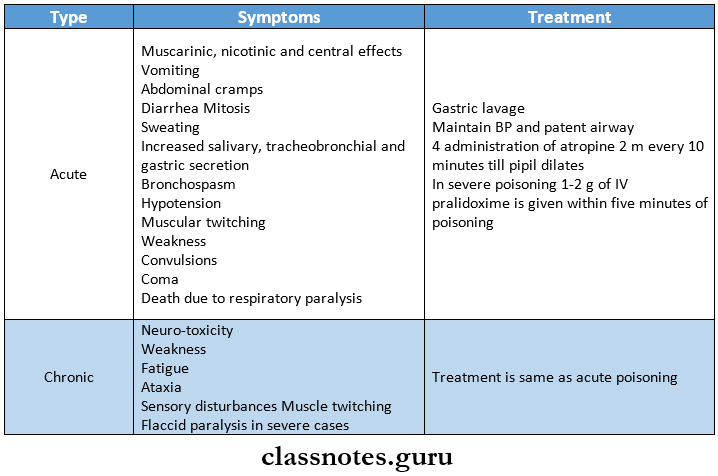Acute Poisoning And Environmental Emergencies Short Answers
Question 1. Fluorosis
Answer:
Fluorosis
Dental fluorosis is caused by excessive intake of fluoride during tooth development
Fluorosis Clinical Features
- Lustreless, opaque white patches in the enamel which may become mottled, striated, or pitted
- Mottled areas may become stained yellow or brown
- Hypoplastic areas may also be present to such an extent in severe cases that normal tooth form is lost
- Enamel fluorosis is a developmental phenomenon due to excessive fluoride ingestion during amelogenesis
- Once crowns are formed no further fluorosis occurs
- The hypocalcified areas of the mottled enamel are less soluble in acids
- They have a greater permeability to dyes
- They emit fluorescence of higher intensity then normal enamel
- Fluorosis occurs symmetrically within arches
- The premolars is usually first affected followed by second molar, maxillary incisor, canine, first molar, and mandibular incisors
Acute poisoning symptoms
Read And Learn More: General Medicine Question and Answers
Question 2. Food poisoning
Answer:
Food poisoning Management:
- Resuscitation and initial stabilization
- Diagnosis of type of poison by
- History
- Examination
- Laboratory investigations
- Nonspecific therapy- to reduce the levels of toxin
- Specific therapy- to reduce toxic effects on the body
- Supportive care- to support functions of vital organs
Question 3. Arsenic poisoning
Answer:
Arsenic poisoning Features:
- Gingivitis
- Stomatitis
- Painful mucosal ulceration
- Hyperpigmentation and hyperkeratosis
- Excessive salivation
- Vomiting
- Diarrhea
- Neurological disturbances
Types of acute poisoning
Question 4. Barbiturate poisoning
Answer:
Barbiturate Poisoning
- Fatal dose of phenobarbitone is 6-10 gram
Barbiturate Poisoning Symptoms:
- Respiratory depression with slow and shallow breathing
- Hypotension
- Skin eruptions
- Cardiovascular collapse
- Renal failure
Barbiturate Poisoning Treatment:
- Gastric lavage followed by administration of activated charcoal
- Maintain BP
- Airway maintenance
- Adequate ventilation
- Oxygen administration
- Forced alkaline diuresis with sodium bicarbonate, a diuretic, and 4 fluids
- Hemodialysis
Poisoning first aid measures
Question 5. Scorpion bite
Answer:
Types Of Scorpion Venom:
- Venom of the genera Hadrurus, Vejovis, and Uroctonus Effects:
- Sharp burning
- Swelling
- Discoloration at the bite site
- Rarely anaphylaxis
- Venom produced by genera of the poisonous varieties of centuries Effects
- Block sodium channels
- Spontaneous depolarization of parasympathetic and sympathetic nerves
- Tachycardia
- Hypertension
- Sweating
- Piloerection
- Hyperglycemia
- Pulmonary edema
- Seizures
- Scorpion Venom Treatment:
- Patient is hospitalised for at least 12 hours
- Maintain airway maintenance
- Administration of 1-2 vials of intravenous anti-venin
Common household poisoning agents
Question 6. Lead poisoning
Answer:
Lead Poisoning Features:
- Excessive salivary secretions
- Metallic taste in the oral cavity
- Swelling of the salivary glands
- Development of the dark lead line along the gingival margin
- Convulsions
- GI upset
- Anaemia
- Neuritis
- Basophilic stippling of the RBC cells
Question 7. Adverse drug reactions
Answer:
Adverse Drug Reactions Definition:
- It is defined as any response to a drug that is noxious and unintended and that occurs at the dose used in man for prevention, diagnosis, or therapy
Adverse Drug Reactions Types:
- Side effects
- They are unwanted effects of a drug
- Toxic effects
- They are seen with higher doses of the drug
- Intolerance
- A person cannot tolerate a drug
- Idiosyncrasy
- It is a genetically determined abnormal reaction to a drug
- Allergic reactions
- They are immunologically mediated reactions
- Iatrogenic diseases
- These are drug-induced diseases
- Drug dependence
- It is a state of compulsive use of drugs despite the knowledge of the risks associated with its use
- Teratogenicity
- A drug can cause fetal abnormalities when administered to a pregnant woman
- Teratogenicity and mutagenicity
- Drugs causing cancers and genetic abnormalities
Drug overdose emergency treatment

Question 8. Organophosphorous poisoning
Answer:
Organophosphorous Poisoning

Organophosphate poisoning symptoms
Question 9. Thrush
Answer:
Thrush
- Acute pseudomembranous oral candidiasis is also known as thrush
Thrush Common Sites Involved:
- Buccal mucosa
- Tongue
- Palate
Thrush Etiology:
- Causative organism- Candida albicans
- Prolonged antibiotic therapy
- Immuno-suppression
Thrush Predisposing Factors:
- Infancy
- Debilitating illness
- Metabolic diseases
- Diabetes
- Hypothyroidism
Thrush Features:
- Foul taste
- This leads to inflammation, erythema, and eroded areas
- Presence of adherent white plaques
- It can be removed by scraping
- It is more common in women
Thrush Treatment:
- Anti-fungal antibiotics
- Nystatin
- Amphotericin suspension or lozenges
- For AIDS patient
- Oral fluconazole is used
Carbon monoxide poisoning treatment
Question 10. Halitosis
Answer:
Halitosis Definition:
- Unpleasant odor exhaled in breathing is called halitosis
Halitosis Classification:
- Physiologic
- Pathologic
- Oral
- Extraoral
Halitosis Causes:
- Physiologic
- Mouth breathing
- Medication
- Fasting
- Aging
- Tobacco
- Food
- Pathologic
- Periodontal infection
- Tongue coating
- Stomatitis
- Xerostomia
- Faulty restoration
- Unclean denture
- Ulcers
- Abscess
- Systemic diseases
Halitosis Treatment:
- Scaling
- Irrigation
- Burning sensation
- Tongue brushing
- Use of mouth rinse
- Use of Halita
Question 11. Macroglossia
Answer:
Macroglossia Definition:
- Macroglossia is a relatively common condition characterized by an increase in the size of the tongue
Macroglossia Types And Causes
- Congenital macroglossia
- Overdevelopment of the tongue musculature
- Lysosomal storage diseases
- Down’s syndrome
- Multiple endocrine neoplasia syndrome
- Acquired macroglossia
- Tumours in the tongue
- Amyloidosis
- Endocrine disorders
- Lymphatic obstruction in the tongue
- Cystic lesions in the tongue
Macroglossia Clinical Features:
- Causes displacement of teeth and malocclusion
- Disturbances in speech and feeding
- Cosmetic deformity
- Indentation or scalloping on the lateral margins of the tongue
- Development of tongue-thrusting habits
- Airway obstruction
Macroglossia Treatment:
- Removal of the primary cause
- Surgical reduction or trimming
Management of acute poisoning in hospital
Question 12. Ciprofloxacin
Answer:
Ciprofloxacin
- Ciprofloxacin is the first generation of fluoroquinolone
Ciprofloxacin Uses:
- Urinary tract infection
- Typhoid
- Diarrhea
- Gonorrhea
- Chancroid
- Respiratory tract infection
- Bone, joint, soft tissue, and intra-abdominal infections
- Tuberculosis
- Bacterial prostatitis and cervicitis
- Eye infections
- Anthrax
- Orodental infections
Ciprofloxacin Adverse Reactions:
- Nausea, vomiting, abdominal discomfort, diarrhea
- Rashes
- Tendinitis
- Damages growing cartilage
Treatment of organophosphorus poisoning
Question 12. Phenobarbitone
Answer:
Phenobarbitone
- Phenobarbitone is an anti-epileptic drug
Mechanism of Action:
- Enhances inhibitory neurotransmission in the CNS
- Enhances activation of GABA receptors
- Facilitates GABA-mediated opening of chloride ion channels
Phenobarbitone Uses:
- Generalized tonic-clonic seizures
- Partial seizures
Phenobarbitone Adverse Reactions:
- Sedation
- Tolerance
- Nystagmus
- Ataxia
- Megaloblastic anemia
- Osteomalacia
- Skin rashes
- Hypersensitivity reactions
